To create an enchanting spring perfume, you'll want to combine bright floral oils like lavender, geranium, and ylang-ylang with energizing citrus notes such as sweet orange and bergamot. Add depth with earthy base notes like cedarwood or sandalwood, following a 30/50/20 ratio of top, middle, and base notes. Store your blend in dark glass bottles and use within six months for the best results. Discover how these natural oils can transform into your signature springtime scent.
Essential Oils That Capture Spring's Essence
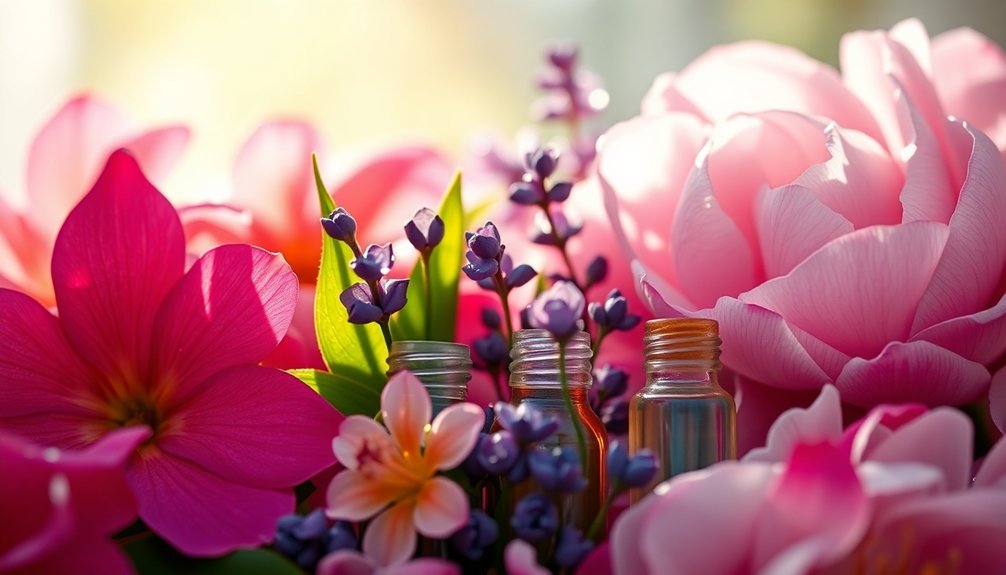
When spring arrives, certain essential oils perfectly capture the season's vibrant spirit and natural renewal.
You'll find that floral essential oils like Lavender and Geranium create an uplifting atmosphere that mirrors the season's awakening energy. These oils bring balance and evoke feelings of growth and rejuvenation.
Citrus essential oils add another dimension to your spring perfume collection. Sweet Orange and Grapefruit provide bright, invigorating notes that energize your senses.
When you combine these with the exotic sweetness of Ylang Ylang, you'll create a blend that promotes both relaxation and joy.
For additional depth, incorporate herbaceous oils like Rosemary and Basil, which contribute fresh, green notes reminiscent of spring's abundant herb gardens.
These thoughtful combinations deliver both delightful aromas and mood-enhancing benefits.
Understanding Perfume Note Categories
A symphony of scents unfolds in layers when you create natural perfumes, with each note category serving a distinct purpose in the fragrance journey. When crafting essential oil blends, you'll work with three distinct categories that create a complete olfactory experience.
| Note Category | Characteristics |
|---|---|
| Top Notes | Light, fresh, evaporate within 15min-2hrs |
| Middle Notes | Main body, last 3-5hrs |
| Base Notes | Deep, rich, persist several days |
| Best Spring Top Notes | Citrus oils, bergamot, lemon |
| Balanced Blend Ratio | 30% top, 40% middle, 30% base |
You'll find that top notes provide the initial impression, while middle notes form the perfume's heart, and base notes anchor the composition. This layered approach guarantees your natural perfume evolves beautifully throughout the day, creating a complex and lasting fragrance experience.
Top Spring Floral Oils for Natural Perfumes
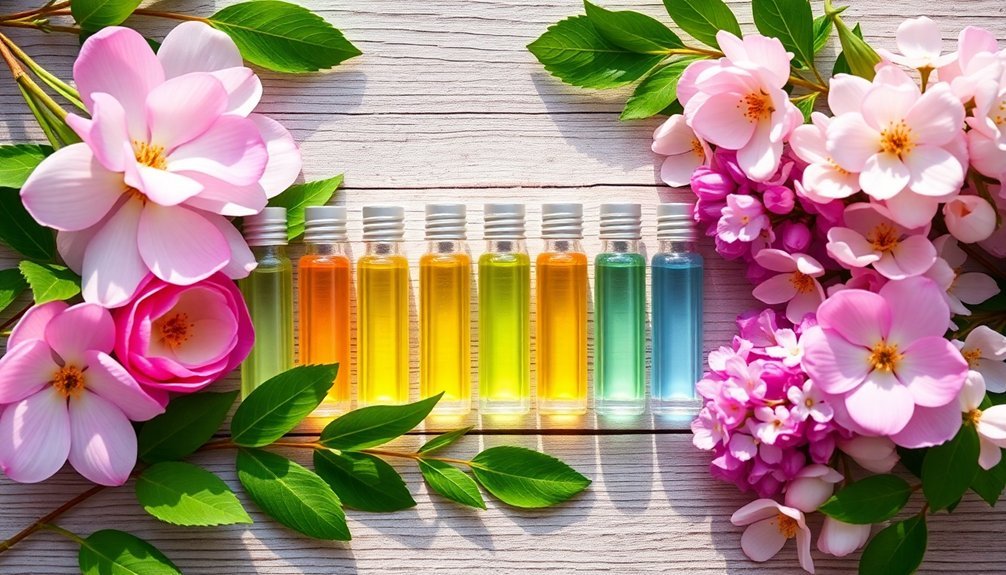
You'll find endless possibilities when pairing gentle florals like lavender and geranium, which create a harmonious base for natural spring perfumes.
For fresh springtime combinations, try blending the exotic sweetness of ylang ylang with the bright, citrusy notes of neroli to capture the essence of a blooming garden.
The addition of jasmine can transform your blend into a more luxurious scent while maintaining the light, uplifting qualities that define spring fragrances.
Gentle Floral Oil Pairings
Spring's most enchanting floral oils create harmonious natural perfumes that capture the essence of the season.
You'll find that lavender essential oil pairs beautifully with geranium essential oil, creating a balanced blend that soothes your mind while uplifting your spirits.
For a more exotic combination, try mixing ylang ylang with neroli essential oil. This pairing produces a soft yet vibrant scent that promotes both tranquility and joy.
If you're seeking a deeply romantic fragrance, combine rose essential oil with lavender, which creates a luxurious blend that evokes warmth and relaxation.
These gentle pairings work together to enhance each oil's natural properties, delivering a more complex and satisfying aromatic experience.
You'll discover that these thoughtful combinations offer the perfect foundation for your springtime natural perfumes.
Fresh Spring Scent Combinations
When creating fresh spring perfume blends, start with vibrant floral essential oils that capture the season's essence.
You'll find that combining Lavender and Geranium creates a calming base, while adding Sweet Orange or Bergamot brings an energizing lift to your essential oil blend.
For a more exotic touch, incorporate Ylang Ylang into your Floral Essential mixture. This sweet note pairs beautifully with citrus oils and adds emotional balance to your perfume.
To create depth, blend in herbaceous Rosemary, which complements the floral notes while offering therapeutic benefits.
Finally, anchor your spring fragrance with Cedarwood, which grounds the lighter scents and provides lasting stability.
These combinations work together to capture spring's invigorating spirit while delivering a well-rounded, natural perfume that'll enhance your mood throughout the season.
Citrus Oils That Brighten Your Blend
Your spring perfume blend comes alive with zesty orange essential oil's mood-boosting effects and natural antimicrobial properties.
Bergamot's fresh, citrusy aroma offers both calming and uplifting qualities, making it a versatile addition to your natural fragrance.
When you layer these bright citrus notes together, you'll create an energizing top note that instantly lifts your spirits while setting the foundation for deeper, lasting scents.
Zesty Orange Essential Benefits
The radiant essence of orange essential oils brings an unmistakable brightness to natural spring perfumes. When you incorporate zesty orange essential oils into your blends, you'll experience their powerful mood-lifting properties that help reduce stress and anxiety while boosting your overall sense of well-being.
These vibrant oils don't just smell incredible – they're also working hard to purify the air around you through their natural antibacterial qualities. You'll find they pair beautifully with floral and mint notes, creating invigorating combinations that capture spring's revitalizing spirit.
Whether you're using Sweet Orange or Blood Orange, these energizing oils will transform your natural perfume into an uplifting experience. They're particularly effective in springtime blends when you're looking to invigorate your senses and embrace the season's renewed energy.
Uplifting Bergamot Properties
Bright and effervescent, bergamot essential oil stands as a cornerstone in natural spring perfumery. You'll find this citrus gem uniquely capable of uplifting your mood while adding a sophisticated touch to your natural fragrance blends. Extracted from the peel of bergamot oranges, this oil delivers both aromatic beauty and therapeutic benefits.
When you're crafting spring perfumes, you'll appreciate how bergamot essential works harmoniously with other citrus oils, floral notes, and herbal elements. Its stress-reducing properties make it particularly valuable for creating calming yet invigorating scents.
Beyond its delightful aroma, you'll benefit from its antibacterial qualities, which can support skin health in body care blends. Whether you're battling winter blues or seeking emotional balance, bergamot's bright, uplifting nature makes it an indispensable addition to your spring perfume collection.
Combining Citrus Scent Notes
Combining fresh citrus oils creates an exhilarating symphony of scents that can transform your spring natural perfume into a mood-lifting elixir. You'll discover that blending different citrus notes enhances both the fragrance's complexity and its therapeutic benefits.
| Citrus Oil | Top Note Profile | Wellness Benefit |
|---|---|---|
| Lemon | Bright & Sharp | Energizing |
| Grapefruit | Zesty & Fresh | Mood-lifting |
| Bergamot | Sweet & Citrusy | Stress-reducing |
When you're crafting your spring blend, start with these vibrant citrus oils as your top notes. They'll provide an immediate burst of freshness while working synergistically with floral or mint undertones. You'll find that these combinations don't just smell incredible – they'll help combat fatigue and seasonal blues while naturally protecting against bacteria with their antimicrobial properties.
Base Notes for Lasting Spring Fragrances
When crafting natural spring perfumes, you'll need strong base notes to anchor your fragrance and guarantee it lasts throughout the day. Your base notes will account for 15-30% of your blend, providing the critical foundation that allows your scent to evolve beautifully over time.
Consider incorporating earthy vetiver or rich sandalwood as your primary base notes. These powerful ingredients help ground the lighter elements of your spring fragrance while adding essential depth.
Frankincense essential oil offers a resinous quality that pairs exceptionally well with floral components, enhancing your perfume's complexity. Don't overlook patchouli, which brings musky undertones that perfectly balance bright citrus and delicate floral notes.
These base notes continue to work their magic hours after the top and middle notes have faded, ensuring your spring perfume maintains its allure.
Therapeutic Benefits of Spring Oil Combinations
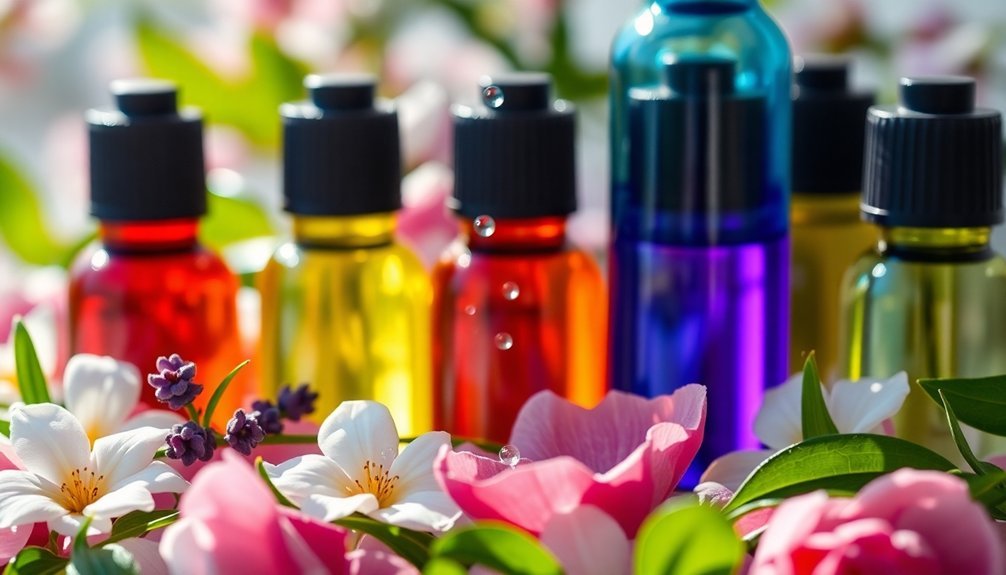
Beyond their enchanting aromas, spring essential oils offer powerful therapeutic benefits that enhance both your perfume and well-being. When you blend floral oils like lavender and ylang-ylang, you'll create perfume blends that help reduce anxiety while boosting self-esteem.
The combination of citrus oils, such as sweet orange and grapefruit, can lift your mood and energize your spirit throughout the day.
For maximum therapeutic benefits, try pairing lavender with bergamot to achieve emotional balance and stress relief. If you're seeking mental clarity, add eucalyptus to your spring perfume combinations.
You'll find that these natural fragrances don't just make you smell wonderful – they actively support your emotional health while providing a revitalizing alternative to synthetic perfumes.
Blending Ratios for Perfect Spring Scents
Creating your spring perfume blend starts with understanding the golden ratio of 30% top notes, 50% middle notes, and 20% base notes.
You'll want to combine 3-5 drops of bright citrus oils like Bergamot for top notes, followed by 5-10 drops of floral middle notes such as Geranium or Ylang Ylang.
For a balanced composition, anchor your blend with 2-4 drops of base notes like Cedarwood, and remember to maintain the overall concentration at 7-10 drops per ounce of carrier oil.
Proportions For Floral Combinations
The art of blending floral essential oils demands precise proportions to achieve an enchanting spring perfume. For the Best Essential Oils combinations, you'll want to follow the 30-50-20 rule: 30% top notes, 50% middle notes, and 20% base notes.
When creating proportions for floral combinations, start with a simple blend of three oils. Try 3 drops of lavender and 2 drops of geranium as middle notes, complemented by 1 drop of ylang ylang as your base note.
For a citrus-floral variation, combine 4 drops of sweet orange, 3 drops of rose geranium, and 2 drops of sandalwood.
Remember to test your blend after 24 hours since oil intensities can change. You can always adjust by adding more of your dominant scent if needed.
Essential Oil Mixing Rules
While mastering spring perfume blends might seem intimidating, following essential oil mixing rules will guarantee your success.
When creating your essential oil blend, start with a balanced ratio of 30% top notes, 50% middle notes, and 20% base notes. For your perfume recipes, you'll want to mix 5-10% essential oils with your carrier oil, which translates to 15-30 drops per ounce.
Begin with just 3-4 oils to keep your blend manageable. If you're working with stronger scents, use only 1 drop for every 10-20 drops of lighter oils.
Remember to let your creation rest for at least 24 hours before making final adjustments – this waiting period allows the fragrances to develop their true character and merge into a harmonious spring scent.
Creating Your Signature Spring Perfume

Ready to discover your perfect spring scent? Start by selecting floral essential oils like lavender and geranium as your perfume's heart.
These oils create an uplifting foundation that captures spring's essence of renewal and freshness.
Next, add bright citrus oils such as sweet orange or grapefruit to energize your blend.
These invigorating notes work perfectly with florals while boosting your mood.
For depth and longevity, incorporate woodsy oils like cedarwood or sandalwood as base notes.
They'll ground your fragrance and balance the lighter elements.
For a unique twist, try adding a touch of peppermint to combat seasonal fatigue.
Remember to follow the top, middle, and base note structure when crafting your blend.
This guarantees your signature spring perfume develops beautifully on your skin throughout the day.
Storage and Shelf Life Tips
Now that you've created your signature spring perfume, proper storage will guarantee its freshness and potency.
You'll want to store your creation in a dark glass bottle, preferably amber or cobalt, as these colors protect essential oils from harmful UV rays that can trigger oxidation.
Keep your perfume in a cool, dark location to maintain its fragrance integrity.
Since natural perfumes have a shorter shelf life than synthetic ones, especially those containing citrus oils, plan to use yours within six months.
You can extend this timeframe by adding a few drops of vitamin E oil, which helps prevent oxidation.
Don't forget to check your perfume regularly for any changes in color or scent.
If you notice anything unusual, it's best to create a fresh batch rather than risk using spoiled product.
Popular Spring Perfume Recipes
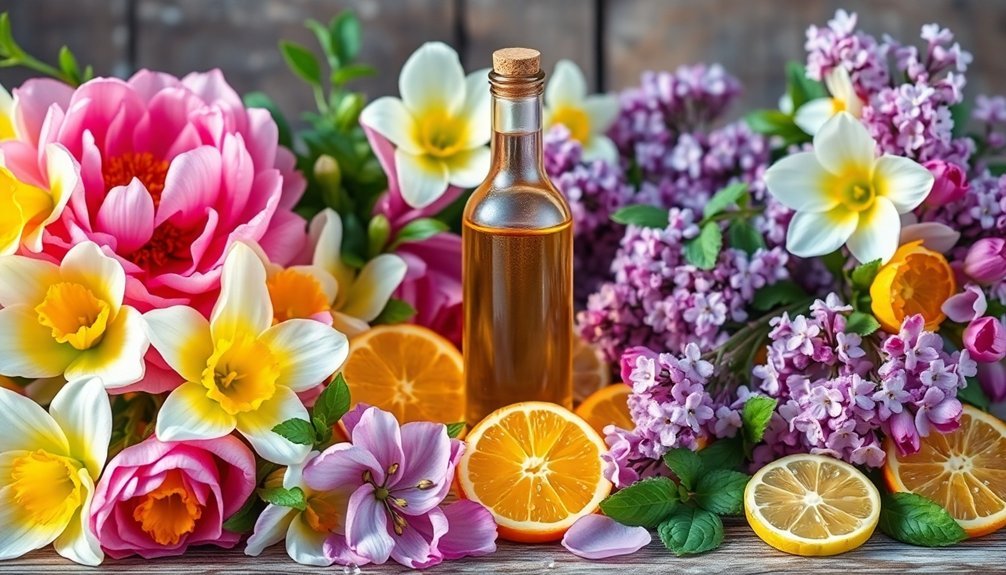
Spring's most enchanting perfume recipes capture the season's vibrant energy through carefully crafted essential oil combinations.
You'll love "Flower Power," a natural perfume that blends Geranium, Lavender, and Chamomile Roman essential oils for a true floral experience.
For a mood boost, try "Tropical Escape" with Ylang-Ylang and Patchouli essential oils, offering both energy and calm.
If you're seeking romance, "Springtime Love" combines Amyris and Ylang-Ylang with Sweet Orange to enhance self-confidence.
Want to recreate spring rain? Mix Cedarwood, Rosemary, and Ylang-Ylang in "April Showers Bring May Flowers."
For bright, uplifting scents, combine citrus essential oils like Sweet Orange, Bergamot, and Grapefruit – they'll instantly transport you to a sun-filled spring morning.
Customizing Your Spring Fragrance
When creating your unique spring fragrance, understanding the art of blending essential oils opens up endless possibilities for personal expression.
Start by selecting floral oils like Geranium and Ylang Ylang to capture spring's blooming essence, then add energizing citrus notes such as Sweet Orange or Grapefruit.
The key to customizing your perfect spring scent lies in balancing different notes.
Combine top notes (citrus), middle notes (florals), and base notes (Cedarwood) to achieve a well-rounded fragrance.
You'll find that mixing relaxing Lavender with uplifting citrus creates an engaging personal blend that suits your mood.
Remember to store your custom creation in dark glass bottles and keep them in a cool place to maintain the oils' potency and extend their lifespan.
Seasonal Oil Pairing Guidelines
Building on your custom fragrance knowledge, let's explore proven oil combinations that work harmoniously during the spring season.
When pairing essential oils for springtime perfumes, you'll want to create balanced blends that capture the essence of renewal and freshness.
- Combine floral essential oils like Lavender and Geranium with Sweet Orange or Grapefruit to create an uplifting, garden-fresh aroma.
- Layer Eucalyptus or Rosemary with citrus oils for a clean, invigorating scent that helps clear your mind.
- Mix Lavender with Cedarwood to achieve a perfect balance between light floral notes and grounding woody undertones.
- Blend Geranium with Frankincense to create a sophisticated fragrance that maintains spring's lightness while adding depth.
These combinations will help you craft the perfect seasonal perfume that captures spring's rejuvenating spirit.
Safety Considerations for Natural Perfumes
Safety remains paramount when creating and applying natural perfumes, even though these botanical ingredients come from nature.
Before using any new blend, you'll need to conduct a patch test on a small area of skin to check for potential reactions or sensitivity.
When working with essential oils, always choose high-quality products without synthetic additives.
You'll want to follow proper dilution guidelines – stick to a 2% dilution ratio, using roughly 4 drops of essential oil per 10 mL of carrier base.
Store your finished perfumes in dark glass bottles to preserve their potency and prevent degradation from UV exposure.
Be careful with citrus oils in your spring blends.
If you're using lemon or bergamot, don't apply your perfume before heading into the sun, as these oils can cause photosensitivity.
Frequently Asked Questions
What Is the Best Oil for Natural Perfume?
You'll find Lavender, Ylang Ylang, and Geranium are top choices for natural perfume. When you combine these with Cedarwood or Frankincense as base notes, you'll create a beautifully balanced fragrance.
What Makes a Good Spring Fragrance?
You'll create a perfect spring fragrance by combining bright citrus oils with floral notes like lavender and ylang-ylang. Add mint for freshness, and you'll capture spring's essence of renewal and energy.
How to Make 100% Natural Perfume?
Fill a spray bottle 3/4 with rose water, add your chosen essential oils until you've reached 5% concentration. Mix gently, let it sit for 24 hours, and store in a dark bottle.
What Essential Oil Makes the Best Perfume?
You'll find Lavender, Ylang Ylang, and Sandalwood make excellent perfume bases. For a well-rounded scent, add citrus oils like Sweet Orange. These combinations create complex, long-lasting fragrances you'll love wearing.
In Summary
With your newfound knowledge of spring essential oils, you're ready to create your own signature natural perfume. Remember to balance your floral, citrus, and base notes while following safe dilution guidelines. Start with simple blends and gradually experiment with more complex combinations. You'll soon discover that crafting natural spring fragrances isn't just rewarding—it's a personal expression of nature's finest scents.
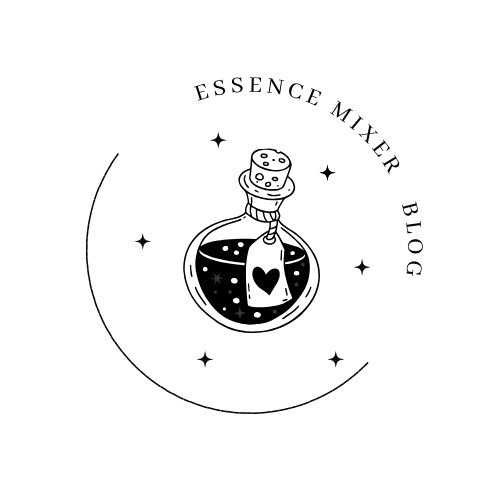
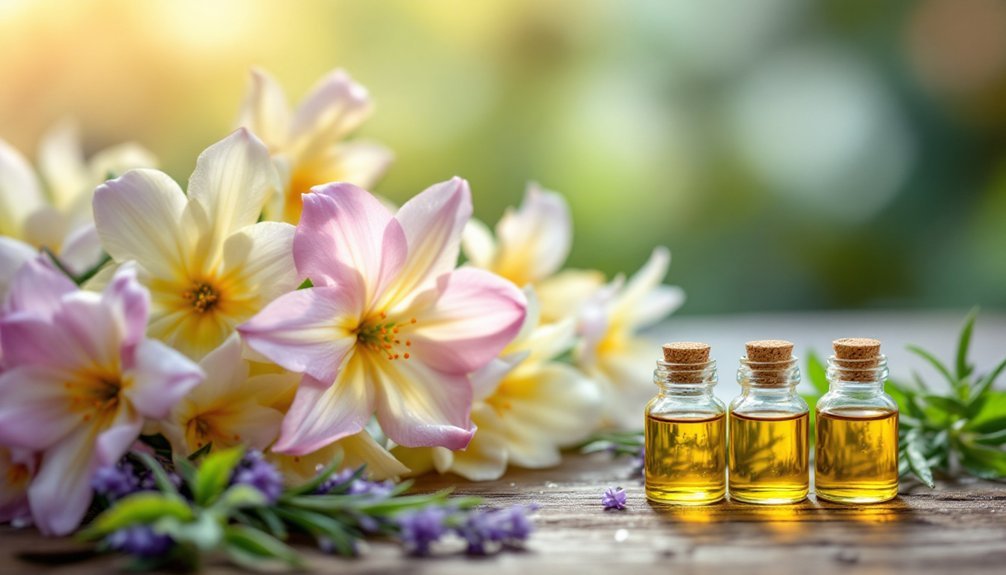



Leave a Reply